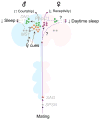Sex differences in Drosophila behavior: Qualitative and Quantitative Dimorphism
- PMID: 30386833
- PMCID: PMC6205217
- DOI: 10.1016/j.cophys.2018.04.004
Sex differences in Drosophila behavior: Qualitative and Quantitative Dimorphism
Abstract
The importance of sex as a biological variable is being recognized by more and more researchers, including those using Drosophila melanogaster as a model organism. Differences between the two sexes are not confined to well-known reproductive behaviors, but include other behaviors and physiological characteristics that are considered "common" to both sexes. It is possible to categorize sexual dimorphisms into "qualitative" and "quantitative" differences, and this review focuses on recent advances in elucidating genetic and neurophysiological basis of both qualitative and quantitative sex differences in Drosophila behavior. While sex-specific behaviors are often mediated by sexually dimorphic neural circuits, quantitative sexual dimorphism is caused by sex-specific modulation of a common neuronal substrate.
Conflict of interest statement
Declaration of interest: None.
Figures



References
-
- Jazin E, Cahill L. Sex differences in molecular neuroscience: from fruit flies to humans. Nat Rev Neurosci. 2010;11:9–17. - PubMed
Grants and funding
LinkOut - more resources
Full Text Sources
Molecular Biology Databases
